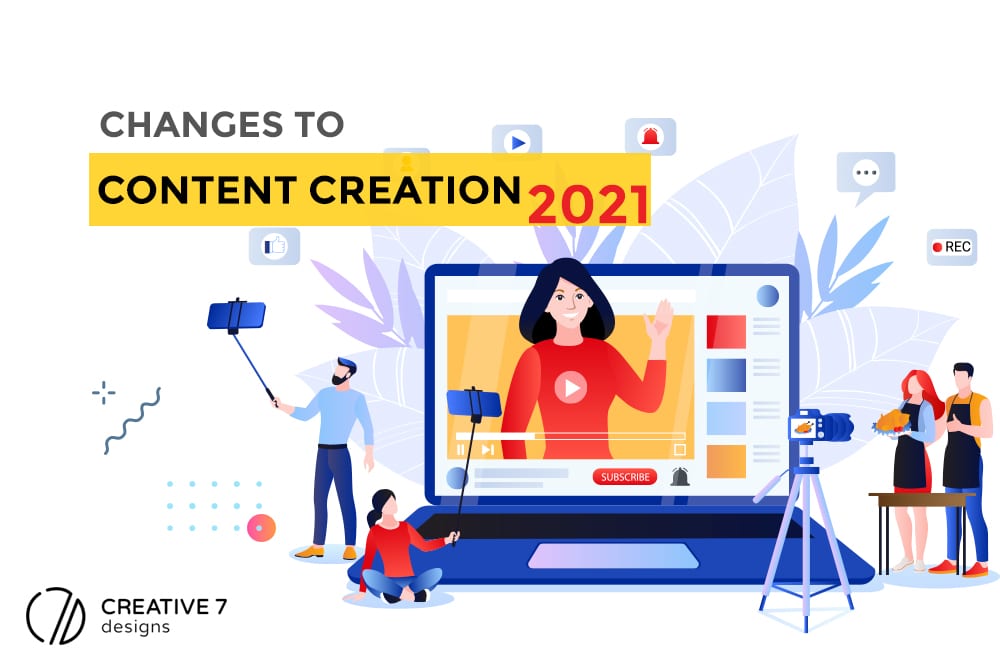Summary: Virtual reality, clutter-free content, diversity and inclusion are some changes in the 2021 content creation scene.
 If you ask us how the 2021 content creation scene has changed, the list of our observations would likely go on… and on… and on. In both subtle and obvious ways, content creation is one of those things that never really stays put. In fact, research shows that consumers use search engines to find content more pointedly.
If you ask us how the 2021 content creation scene has changed, the list of our observations would likely go on… and on… and on. In both subtle and obvious ways, content creation is one of those things that never really stays put. In fact, research shows that consumers use search engines to find content more pointedly.
But the reason content creation is an ever-changing landscape is because content relies on current information. Good content needs the “now and new” appeal to do what it does best — which is inform its audience about what’s going on in any and every industry. This information could be delivered in the form of writing (blogs, emails, etc.), audio (podcasts), and even visual conglomerates (videos).
In today’s blog, we’re going to be focusing on specific aspects of content marketing that has changed over the years, how and/or why its changed, and what we could expect:
Video Marketing
Virtual Reality
Clutter-free Content
Diversity, Equity, & Inclusion
Related article(s):
VIDEO CONTENT WILL CONTINUE TO RULE
It’s true that video has been emerging as one of the most — if not the most — important mediums for content marketing at the end of this past decade. And there’s no indication that this shift in content creation is stopping anytime soon.
By 2017, over 50 percent of consumers wanted to see videos from brands they supported — more than any other kind of content. According to a survey by Wyzowl, 59 percent of marketers who weren’t using video in 2019 expected to be using it throughout 2020. What really happened? In 2020, 85 percent of businesses used video as a marketing tool — that’s a 24 percent jump from 2016. And 92 percent of marketers who use it consider it an important part of their marketing strategy.
People can blame the pandemic for the increased “at-home, online” relationships, but the numbers aren’t decreasing… and they sure don’t lie.
Video marketing is already a staple in several companies’ content marketing operations, and research indicates that medium is going to expand.
The reason for the expanse? Video is inherently engaging. Generally speaking, it’s easier to follow than blog posts, email newsletters, or ebooks. (Do people even read these days, or is that too archaic?)
Gradually, audiences took to video more and more as the decade progressed. By the end of the 2010s, platforms like YouTube were central to the landscape of content marketing.
Related article(s): The Evolution of Content Marketing: How It’s Changed and Where It’s Going in the Next Decade
THE INFLUENCE OF COVID-19 ON THE VIRTUAL REALITY CONTENT CREATION MARKET
We mentioned earlier that the pandemic played a role in certain changes in content creation this year, and it’s true, especially when talking about virtual reality.
In an article surveying the influence of COVID-19 on the Virtual Reality Content Creation Market, we see how every industry — even the pharmaceutical industry — relied on virtual reality to get content out.
“The market research report on the global Virtual Reality Content Creation industry provides a comprehensive study of the various techniques and materials used in the production of Virtual Reality Content Creation market products,” the article says.
In this particular circumstance, Videos 360 Degree Photos Games had been used during the pandemic for the following industries: Gaming and Entertainment, Engineering, Healthcare, Retail, Military, Education, and Others.
And the reason virtual reality increased is obvious: people still want experiences, lockdown or not. Virtual reality gives people the “engagement” and “activity” they need without having to leave their home.
One article says: The industry as a whole is growing at a fast pace, with the global VR market size projected to increase from less than five billion U.S. dollars in 2021 to more than 12 billion U.S. dollars by 2024. Both the enterprise and consumer segments, including the increased development of the VR gaming industry, are expected to profit from the forecast growth.
Related article(s): Virtual Reality Content Creation Market 2021 trends: with Descriptive Analysis and Virtual Reality (VR) – statistics & facts
DELIVER CLUTTER-FREE CONTENT TO USERS
Ironically, with all this content comes over-saturation. Yes, we used the “o” word. What do you do with all those stories, reels, ads, marketplace, etc.? Skip over everything? Scroll endlessly for hours? Completely get rid of social media, purchase a van, and live off the grid just to clear your mind? (We don’t know… ask Facebook and Instagram… they’re the ones who’ve become too feature-heavy lately.)
With more content-like features, there’s bound to be more confusion than curiosity. While such features attract content creators, they could also just as easily distract general users, and not in a good way. No one wants a cluttered user experience… it’s just suffocating.
Clutter-free content means simple and valuable. Not two or three relevant pieces of content sprinkled in a sea of ads.
So, what does clutter-free content look like for the future? Well, we’re not too sure yet. Maybe a subscription model where content is curated specifically for you. It’s like subscribing for a paid version of the app that’s ad-free, similar to what YouTube does today. But, what do we know?
Related article(s): How The Content Creation Landscape Is Changing in 2021
SHIFTING FROM DIVERSITY AND INCLUSION TO DIVERSITY, EQUITY, AND INCLUSION
Diversity and inclusion have been a topic of priority for some time — with equity being a recent addition to the mix. And one of the biggest changes in content creation this year is that there’s no room for bias in business activities. Businesses are actively showing this by sharing the right content that highlights diversity, equity, and inclusion.
Diversity is the presence of differences that may include race, gender, religion, sexual orientation, ethnicity, nationality, socioeconomic status, language, (dis)ability, age, religious commitment, or political perspective.
Equity is promoting justice, impartiality and fairness within the procedures, processes, and distribution of resources by institutions or systems.
Inclusion is an outcome to ensure those that are diverse actually feel and/or are welcomed.
The recognition of the workplace as a working and learning community for an increasingly diverse workforce has increased the focus on diversity, equity, and inclusion (DEI) over the last several years.
Let’s briefly consider McKinsey’s article, “The participation of Black workers in the US private-sector economy.” Though it focuses specifically on race in the workplace, we know that achieving DEI isn’t only applicable to Black workers. Lack of diversity is a structural and multivariate challenge that cuts across many facets of geography, industry, and occupations, as well as advancement and inclusion in the workplace.
McKinsey continues: Truly making progress will require more than addressing corporate policies; it calls for system-level change, an examination of our broader society, and active collaboration among companies and other stakeholders.
We’re living in an increasingly diverse society — and the desire to accept diversity is increasing. Newer businesses with a younger target audience are happily supporting DEI… are you?
Related article(s): Eliminating Bias To Make Genuine Change Through Your Thought Leadership Activities


